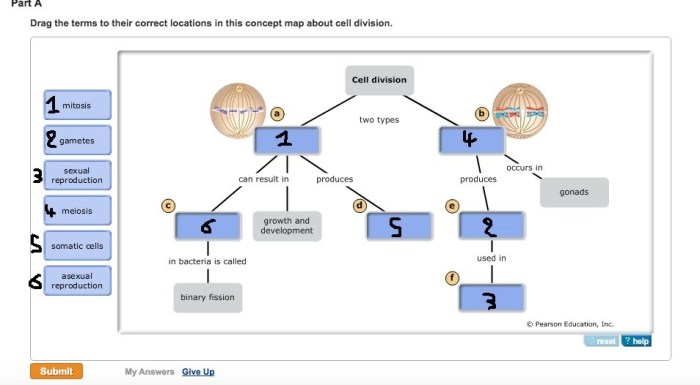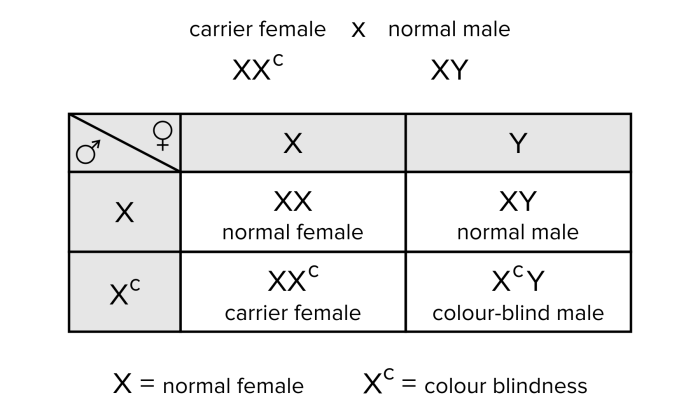Embark on a journey into the intricacies of genetics with our part a meiosis concept map, a roadmap that unravels the mysteries of genetic diversity. Dive into the fascinating world of meiosis, where the blueprint of life is reshuffled and rearranged, laying the foundation for the diversity of life on Earth.
As we delve deeper into the stages of meiosis part A, we’ll explore the key events that shape genetic variation. From the intricate dance of chromosomes during prophase I to the separation of homologous chromosomes in anaphase I, each step holds profound significance in the creation of unique genetic combinations.
Definition of Meiosis Part A
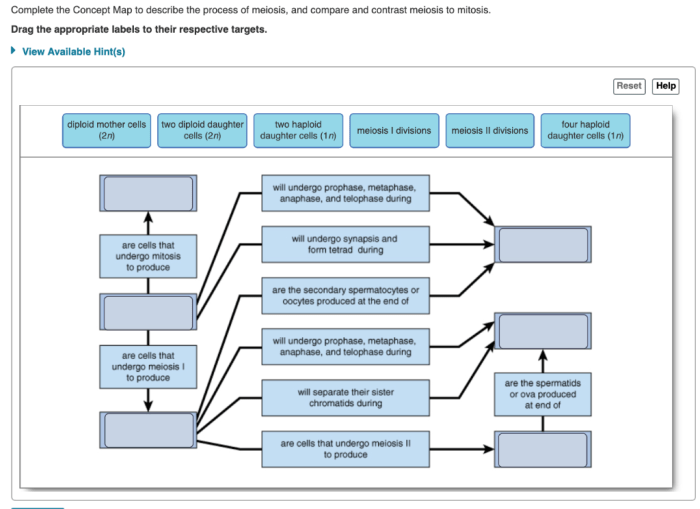
Meiosis Part A, also known as Meiosis I, is the first stage of meiosis, a type of cell division that produces gametes (eggs or sperm) in sexually reproducing organisms. It involves the reduction of the chromosome number from diploid (2n) to haploid (n), ensuring that each gamete carries only one set of chromosomes.
Meiosis Part A is a complex process involving several distinct stages:
Stages of Meiosis Part A
- Prophase I:The chromosomes become visible and undergo a process called crossing over, where homologous chromosomes exchange genetic material.
- Metaphase I:The chromosomes line up at the center of the cell.
- Anaphase I:The homologous chromosomes separate and move to opposite poles of the cell.
- Telophase I:Two haploid daughter cells are formed, each with a single set of chromosomes.
| Stage | Description |
|---|---|
| Prophase I | Chromosomes become visible, crossing over occurs |
| Metaphase I | Chromosomes line up at the center of the cell |
| Anaphase I | Homologous chromosomes separate and move to opposite poles of the cell |
| Telophase I | Two haploid daughter cells are formed |
Key Events in Meiosis Part A
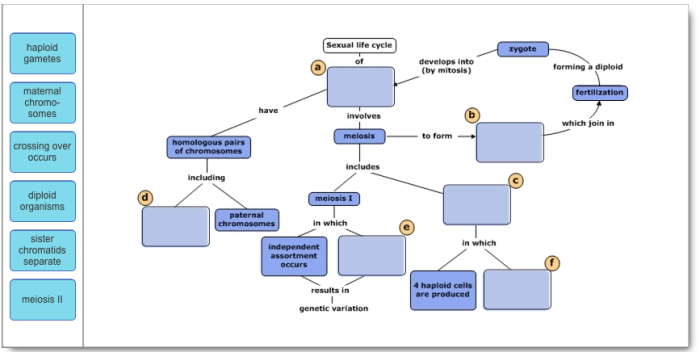
Meiosis Part A, also known as the reduction division, is a crucial process in sexual reproduction. It involves a series of key events that lead to the production of haploid gametes (sex cells). These events ensure genetic diversity and the proper transmission of genetic material to offspring.
Part A of the meiosis concept map offers a concise overview of the process. For a more in-depth exploration of liberty, I recommend checking out the compelling narrative in chapter 19: Give Me Liberty . Returning to our concept map, Part A effectively captures the key stages of meiosis.
Prophase I
Prophase I is the longest and most complex stage of meiosis Part A. It is characterized by several key events:
- Chromatin Condensation:Chromosomes become visible as long, thread-like structures.
- Synapsis:Homologous chromosomes (pairs of identical chromosomes) pair up and align side by side.
- Crossing Over:Homologous chromosomes exchange genetic material, resulting in genetic recombination.
Crossing Over
Crossing over is a critical event in Prophase I that leads to genetic diversity. It involves the exchange of genetic material between non-sister chromatids of homologous chromosomes. This process creates new combinations of alleles, increasing the genetic variability of offspring.
Metaphase I
In Metaphase I, the chromosomes align along the equator of the cell, forming a metaphase plate. The spindle apparatus, a complex network of microtubules, attaches to the chromosomes and prepares to separate them.
Anaphase I
During Anaphase I, the spindle apparatus separates the homologous chromosomes, pulling one chromosome from each pair to opposite poles of the cell. This results in the formation of two daughter cells, each containing a single set of chromosomes.
Significance of Meiosis Part A for Genetic Diversity: Part A Meiosis Concept Map
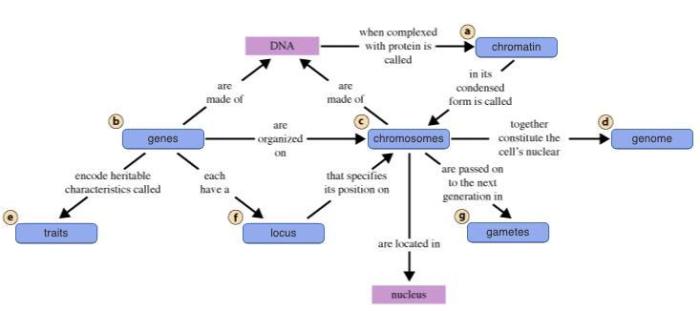
Meiosis Part A plays a pivotal role in promoting genetic diversity within populations. It serves as a crucial mechanism that shuffles and recombines genetic material, contributing to the creation of unique offspring with distinct genetic profiles.
One of the key contributors to genetic diversity is the process of independent assortment during Meiosis Part A. Independent assortment refers to the random distribution of homologous chromosomes during the formation of gametes. This means that each gamete receives a random assortment of chromosomes from each parent, resulting in a vast array of possible combinations.
Role of Independent Assortment in Genetic Variation
Independent assortment significantly increases the genetic diversity within a population. By randomly distributing chromosomes, it ensures that each offspring inherits a unique combination of alleles. This genetic variation is essential for the survival and adaptation of species in changing environments.
Examples of the Importance of Genetic Diversity
Genetic diversity is crucial for the survival of species in several ways:
- Disease Resistance:Genetic diversity allows for a wider range of immune responses within a population, increasing the chances of individuals resisting specific diseases.
- Environmental Adaptation:Genetic diversity provides a reservoir of traits that may be advantageous in changing environmental conditions, such as tolerance to drought or temperature fluctuations.
- Population Stability:Genetic diversity ensures that populations can withstand environmental challenges and recover from genetic bottlenecks, such as natural disasters or disease outbreaks.
Comparison of Meiosis Part A and Meiosis Part B
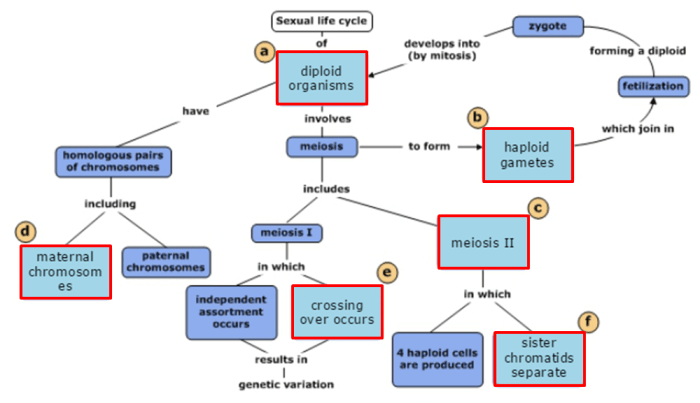
Meiosis Part A and Part B are two distinct stages of meiosis, the process by which sex cells are produced. While they share some similarities, there are also key differences between the two stages.
Key Events
The main difference between Meiosis Part A and Part B lies in the key events that occur during each stage. In Meiosis Part A, homologous chromosomes pair up and undergo crossing over, resulting in the exchange of genetic material. This process contributes to genetic diversity among offspring.
Meiosis Part B, on the other hand, involves the separation of homologous chromosomes and the subsequent division of the cell into four haploid daughter cells.
Similarities and Differences
Despite their differences, Meiosis Part A and Part B share some similarities. Both stages involve the division of the cell into two daughter cells, and both result in the production of haploid cells. Additionally, both stages involve the process of synapsis, in which homologous chromosomes come together and pair up.
Table of Differences, Part a meiosis concept map
The following table summarizes the main differences between Meiosis Part A and Part B:
| Stage | Key Events | Result |
|---|---|---|
| Meiosis Part A | Homologous chromosome pairing and crossing over | Two haploid daughter cells |
| Meiosis Part B | Separation of homologous chromosomes | Four haploid daughter cells |
Key Questions Answered
What is the significance of meiosis part A?
Meiosis part A is crucial for genetic diversity, as it shuffles and recombines genetic material, creating unique combinations of chromosomes in offspring.
How does crossing over contribute to genetic diversity?
During crossing over, homologous chromosomes exchange genetic material, resulting in new combinations of alleles that increase genetic variation.
What is the role of the spindle apparatus in metaphase I?
The spindle apparatus aligns homologous chromosomes along the equator of the cell, ensuring their proper segregation during anaphase I.
